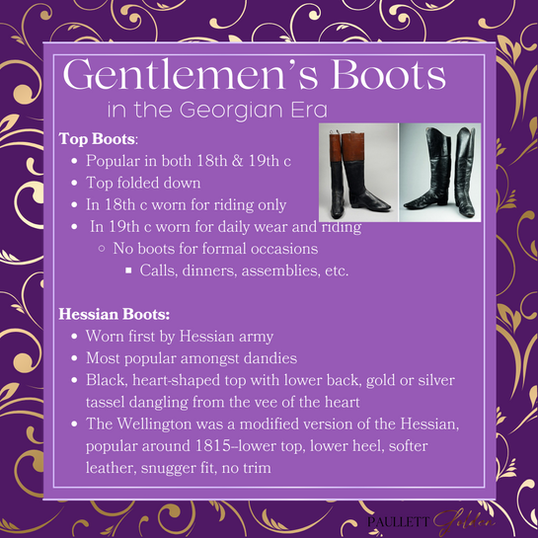Real People. Real Conflict. Real Romance.
Historical Romance
in the style of Jane Austen

Gentlemen's Boots
The preferred boots of the Georgian era
The popularity of wearing boots increased during the 1790s until by the Regency, boots were worn for both daily wear and riding. Prior to the 1790s, boots were only for riding. An 18th century gentleman would have worn pumps (yes, that’s what they were called)—slipper-like shoes with a buckle over the toes, and depending on when in the century, it would have either an impressive heel or a low heel.
During the 1790s, the heels were so low as to be nearly nonexistent. Also during the 1790s, the extravagant shoe colours died out until the preferred pump was black. These pumps would have been worn for all occasions except riding, at least until the 1790s when we see the rise of the boot for daily wear.
There were etiquette rules as to when and where a gentleman could wear his boots, however. Wearing boots within someone’s house, such as for dinner or during a call, and any formal occasion, such as a ball, was a strict no no. A gentleman could wear his boots all about town, all through the country, even on those romantic walks through Hyde Park, but never for anything formal—the gentleman would be turned away at the door if he arrived wearing boots.
There were, initially, two styles of boots: Top Boots and Hessian Boots. Wellingtons became a third style a bit later.
The Top Boot is also called a Hunt Boot and a Riding Boot. This style had been around throughout the 18th century and on into the 19th century, used primarily for riding and hunting. These boots are distinguished by the top of the boot, which is folded down, revealing a lighter tan leather. These were exceptionally tall boots, just below the knees. So beloved were these boots, gentlemen enjoyed being painted wearing them in their portraits, which is an interesting change from the popularity of being painted in one’s banyan!
The Hessian Boot is so named after the Hessian army, which wore this style of boot. This boot became the most popular choice amongst dandies, although both styles were avidly worn. The Hessian is black with a pointed toe to make easing into the stirrup smooth, and a top that was lower in the back with a heart-shaped front and tassel in the vee of the heart—either silver or gold, depending on the time of day or occasion. There was a stylishly low heel on the Hessian. This boot was lower than the Top Boot, rising only a little higher than mid-calf.
The Wellington did not make the scene until around 1815. It was so named because the Duke of Wellington had his Hessian boots modified—soft calfskin leather, trim removed, snugger cut, lower heels, only rose mid-calf. The Wellington eventually replaced the Hessian in popularity and remained so until the 1840s.
When a gentleman wanted a new boot, he would visit a cordwainer. A cobbler would be visited to repair shoes, while a cordwainer made new shoes from new leather. It is more than likely a gentleman would prefer new boots if his boots were in disrepair to having his repaired, but needs must for some, of course.
I think it goes without saying that none of the boots had zippers. Boot pulls and boot jacks were used to help ease the boot on and off without any real effort. If you have a pair of wellies these days, you likely also own a boot pull and/or boot jack—I know I do!
A couple of fantastic sites to explore to learn more:
https://janeausten.co.uk/blogs/mens-fashion/shoes-make-the-man-regency-footwear
https://regencygentleman.wordpress.com/tag/regency-footwear/
